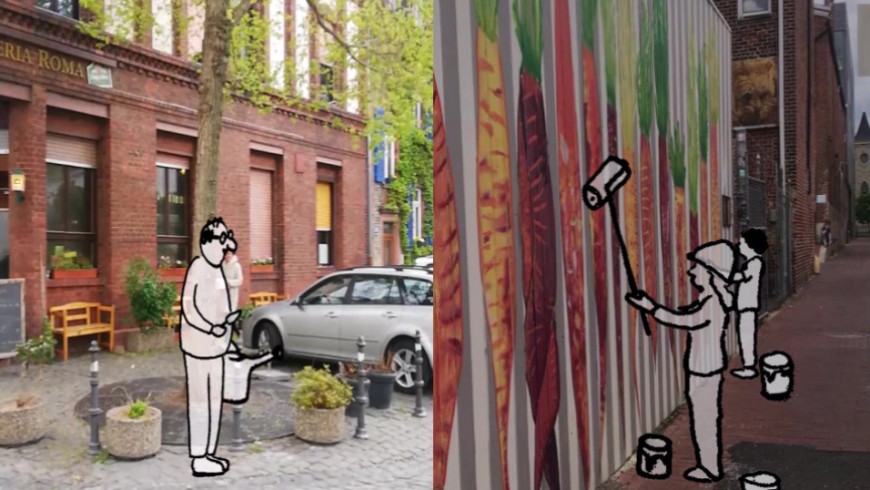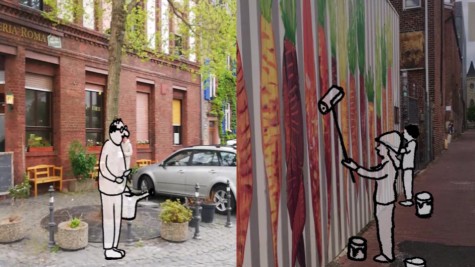What interested you about the seminar? Why did you choose it? Were your expectations met?
Actually, I would not have been in Darmstadt at the time the seminar took place, but in Mexico for a semester abroad. So for me it was like a consolation when I heard about the seminar and an opportunity to get to know a bit of other cultures and ways of life after all – despite the pandemic. In addition, due to the (finally) advancing digitalization, my working life became more and more global. An international seminar was a new experience and only the logical consequence of this development. And yes, the seminar was exactly what it promised in that respect: it took away the feeling of being locked in your dorm room because you were not allowed into the university, and clearly emphasized the achievements of the pandemic.
How was this course different from others?
Apart from the internationality the task required us to work in a way that was desperately necessary in the pandemic situation and the so called lockdown: We had to spent a lot of time outside in the city observing people and their behavior in public spaces, then matched these results with partners, and spent comparatively little time at the screen generating visualizations and other things. I could finally concentrate on the analysis in urban planning in a relaxed and therefore thorough way, without having to “quickly check it off” at the beginning of a design studio. In this way, my group members and I often got into conversation with the residents, learned (both literally and metaphorically) new perspectives on familiar areas and thus also got to know completely new corners of the supposedly well-known city.
How was the cooperation in the international teams? Was there a chance to get to know each other outside of the classes?
Unfortunately, the students from Virginia Tech were in the final submission phase, so the meetings were mainly focused on discussing the content and how to proceed. We hardly talked about everyday life and the different – or sometimes frighteningly similar – challenges in (architecture) studies (“…and what strategies did you develop to keep up with too little sleep for so long?”) and rather made sure that we distributed the workload accordingly.
What problems arose with a course between two continents, two time zones, two languages, two study systems? And how did you solve them?
One of the biggest challenges was communication. Not linguistic communication, but non-verbal communication, which is often at least as important as verbal communication, especially in group work. It was not until three weeks before the final deadline that we managed to reconcile the actual interests of each group member and to align the project in such a way that everyone was happy with it and we all knew what we were aiming for. This was achieved – as is so often the case in group work – by each taking a step back, rethinking the project, and thus finding an acceptable solution for all. In face-to-face meetings within the same cultural group, it becomes clear relatively quickly who has which interests, who is the decision-maker, and who supports which ideas. But due to the digital, the absence of informal exchange and the different ways of communicating opinions, it can obviously take longer at times.
What new did you learn? Was there a particularly striking or surprising finding?
It was very interesting to learn that people in the USA actually drive to the park by car. I thought that these were clichés that could be disproved with this seminar, but we had to realize that some clichés actually have a kernel of truth.
Also, a very interesting experience when we were talking about the accessibility of a certain space for everyone, because of our project, was the way in which people in the U.S. talk about belonging to ethnic groups. Just in the last year, we've heard the differences (and similarities) between the U.S. and Germany over and over again through the media, but it was something very different to actually experience that. So at first it was strange for both sides that 1. in the USA mapping of ethnic groups their place of residence exists in a surprisingly small scale and seems to be completely normal and 2. something like that does not exist in Germany. The next step was then to clarify that we in Darmstadt do not want to divide the people in a neighborhood according to a »race«.
What was your highlight of the seminar?
The highlights were definitely the introductory event, the Gathering and the Workshop. You not only had the time, but also the setting and the task to get to know the other students, which could become quite fast and interesting especially at the workshop by asking specific questions about pretty personal stories, if you got engaged in it. Even though you were just sitting at screens on different sides of an ocean.
All in all, I would like to summarize by quoting a student who said at the end of the seminar: “This was one of the best seminars I have ever attended! Thank you for that!”



